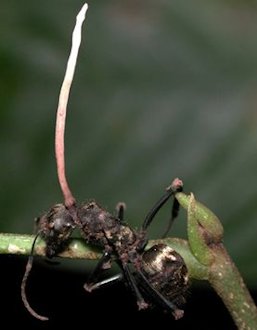
|
Insects Brainwashed by Fungi Parasites - Page 1 Ophiocordyceps unilateralis (Cordyceps unilateralis) The ant in this photograph has fallen victim to parasitic fungi which manipulate the behaviour of their host in order to increase their own chances of reproducing. The spores of the fungus attach themselves to the external surface of the ant, where they germinate. They then enter the ant's body through the tracheae (the tubes through which insects breathe), via holes in the exoskeleton called spiracles. Fine fungal filaments called mycelia then start to grow inside the ant's body cavity, absorbing the host's soft tissues but avoiding its vital organs. The fungus then kills the ant, and continues to grow as its hyphae invade more soft tissues and structurally fortify the ant's exoskeleton. More mycelia then sprout out of the ant, and securely anchor it to the plant substrate while secreting antimicrobials to ward off competition. When the fungus is ready to reproduce, its fruiting bodies grow from the ant's head and rupture, releasing the spores. This process takes four to ten days. ⇦ Back to Page 8 Return to Inspiration On to Page 2 ⇨ |